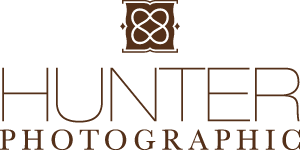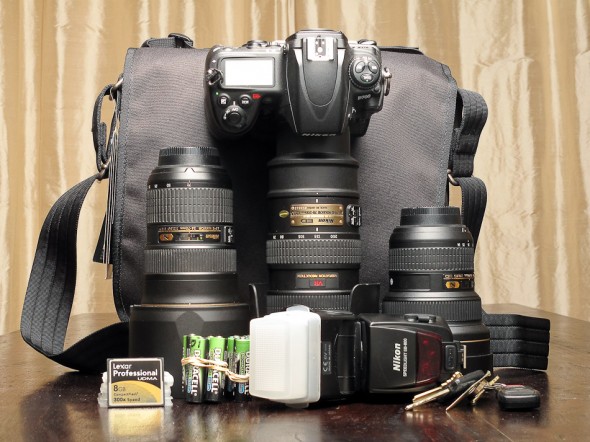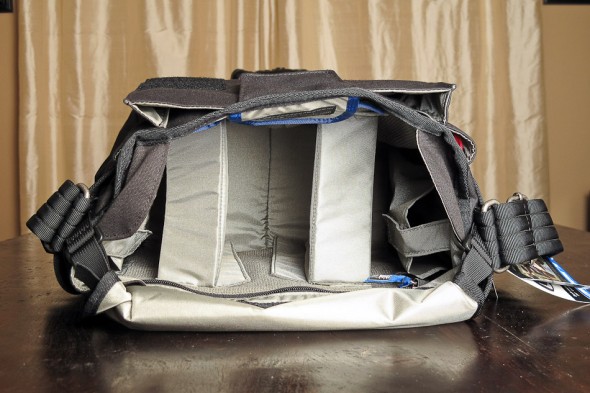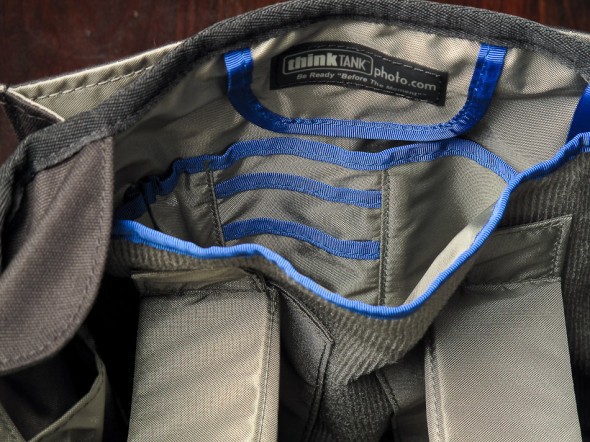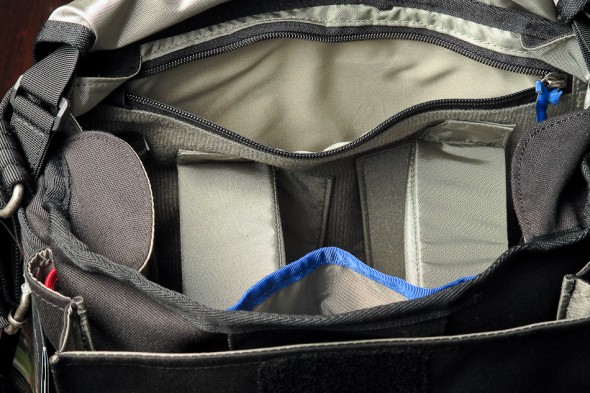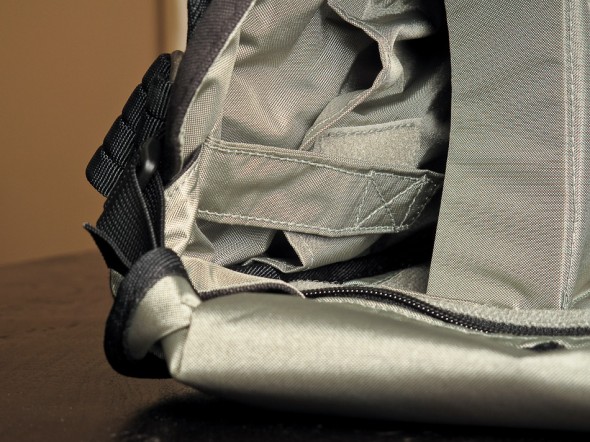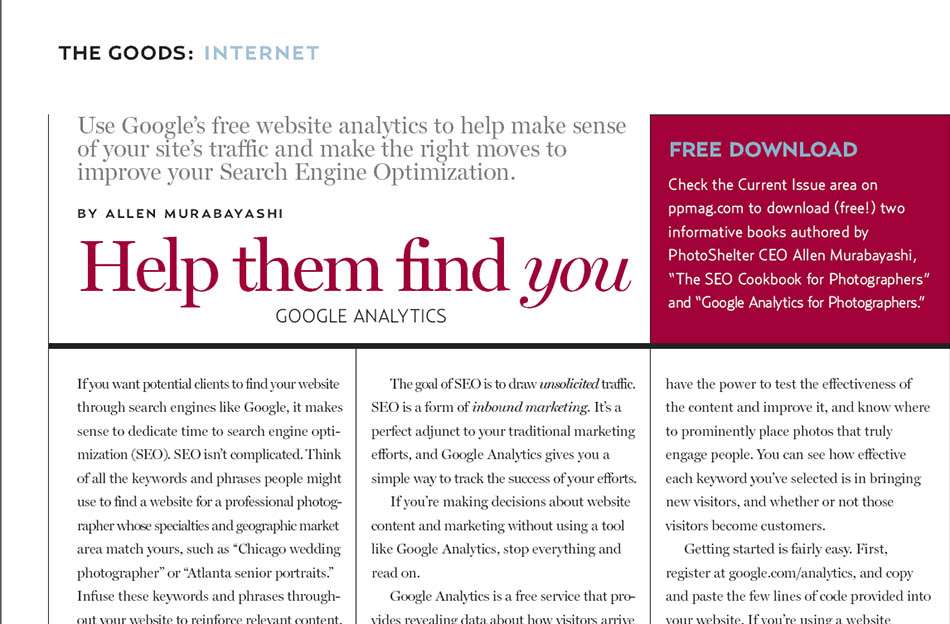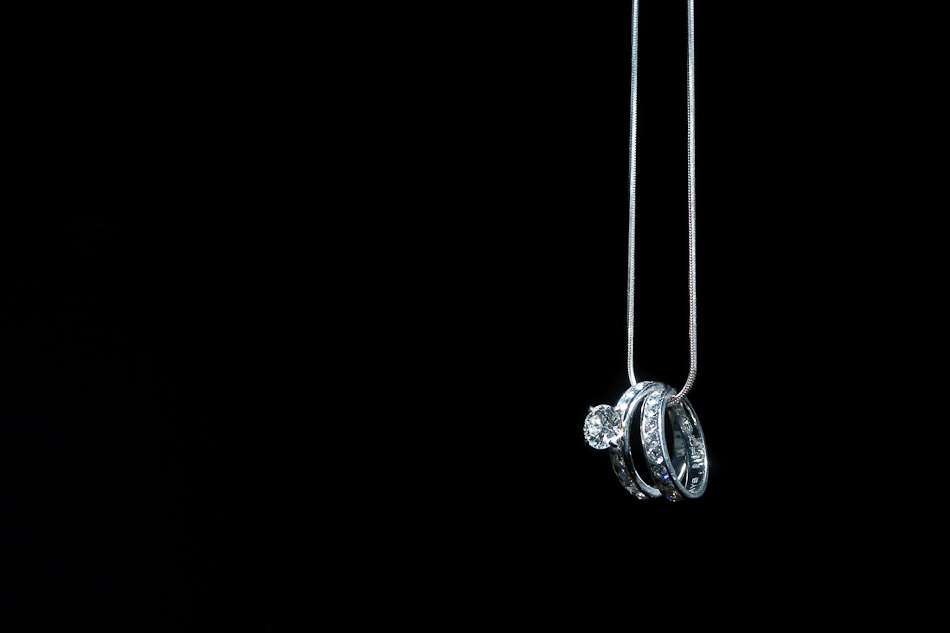What it’s not
Before I discuss all the great things the Think Tank Retrospective 20 does well, you have to understand what this bag is not supposed to be. If you confuse the purpose of this camera bag, then you will be disappointed. However, if you understand the niche this bag fills, then you will be elated. Well, very happy at least.
The Retrospective line of camera bags (in sizes 10, 20, and 30) are not general purpose camera bags. Nor are they good bags for travel or storage since they lack reasonable padding or secure zip or clip closures. The Retrospective bags are not great at carrying laptops with cameras. Lastly, while they hold a lot of gear, they are not intended to hold everything a professional photographer needs.
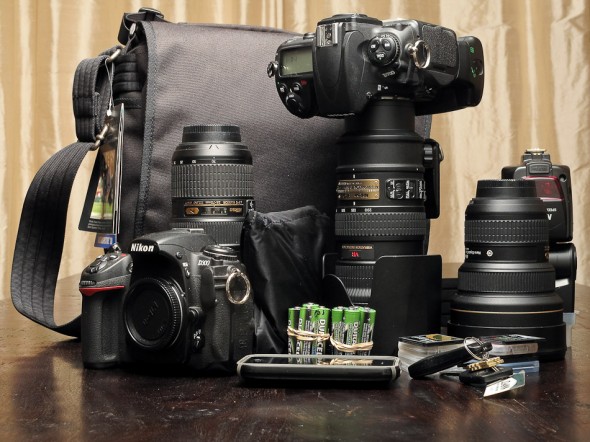
Carrying capacity for the Think Tank Retrospective 20 – D700 with grip, D300, 70-200mm f/2.8 with hood reversed, 24-70mm f/2.8, 14-24mm f/2.8 with hood extended, SB-800 speedlight, spare batteries, memory cards, rain cover, iPhone and car keys with room to spare.
So why are they so special?
The Retrospective bags fill one niche really well – they are the perfect “shoot sack” for working photographers. I cannot tell you how perfect this bag is for comfortably carrying a moderate amount of gear nearly all day long. With the right gear loaded, the Retrospective 20 sits comfortably on the hip with the strap across your shoulder. The strap is built tough, but more on that later.
If you must stuff the Retrospective bag full, have a look at the picture above. The Retrospective 20 can hold all of that photography gear with room to spare. YES, two camera bodies with one grip and three fast lenses. However, I recommend carrying less in the Retrospective 20. In fact, I am wary of the larger Retrospective 30. Carrying too much in either bag is uncomfortable and wears on the shoulders regardless of the excellent strap. For my purpose as a wedding and portrait photographer, the Retrospective 10 is a little small. Then again, I just carry too much gear.
So, simply put – a perfect bag to load up with gear you need access to quickly and often. Perfect for working wedding or portrait photographer, especially when working on location. Definitely not designed to be a travel bag. For travel and storage, move your gear to a well padded and secure bag and simply take the Retrospective 20 along for on-location duty.
With gear reduced to what I really need, as seen above, the Retrospective 20 wears well and feels comfortable across one shoulder. However, you can still see that it holds a lot. Leaving out the extra camera body and knick-knacks gives me the right gear and comfort level, especially with a camera and lens in hand leaving the bag partially empty.
If you typically just work with two lenses, say a fast normal and telephoto zoom, then you may be able to get away with the smaller Think Tank Retrospective 10. Personally, I like a little more space in case I need to squeeze in extra gear. Also, all three Retrospective bags can hold an iPad or small laptop in the outer-back zipped pocket. Keeping something large and ridged in this pocket makes it sit uncomfortably on the hip. Leave the laptop or iPad a travel/storage bag.
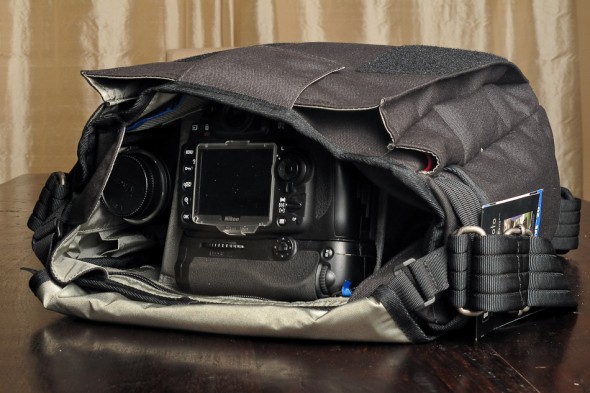
Retrospective 20 filled with a comfortable gear load – One camera with grip, three fast lenses, speedlight and accessories.
Packed up with a comfortable load, the bag does not wear very “thick” at the waist. My arms move comfortably around the bag when I am walking distances. The bag can slip behind the thigh and stay put while walking – much more so than a single camera hanging from a rapid strap. It simply stays at my back and does not flop around much.
Features make the bag
Features will make or break a decent bag. Fortunately, Think Tank does features better than any other professional camera bag company. I also own the Think Tank Airport Security and have looked at Think Tank’s entire line-up. They all come with thoughtful and useful features, including the Retrospective line of bags.
First, the inner-front pocket seen above has the right amount of well-sized mini pockets. The pockets are great for holding the typical small accessories a professional photographer needs. You can see the Think Tank label in the picture above. That is a flap to secure the inner-front pocket closed. If you don’t want the loud velcro RRRRIIIIPPPP during a wedding ceremony, the flap will secure to the side leaving the pocket open. In fact, all of the velcro flaps can be put into “silent mode.”
The inner-back pocket is one deep well and secures with a zipper. Grabbing the zipper is made easy by the large cloth pull attached to the zipper head. The cloth pull is nice since it won’t scratch or wear photo gear inside the bag, especially LCD screens.
Each side of the bag has a pocket that secures with a velcro flap. These two inner-side pockets seem tailor made to hold speedlights, even the giant Nikon SB-900. The flaps can be secured so the pockets stay open in “silent mode.” Even though these pockets seem designed for speedlights, I prefer to keep my speedlight in the front-outer pocket. This leaves more room inside the bag, enabling fast and easy lens changes.
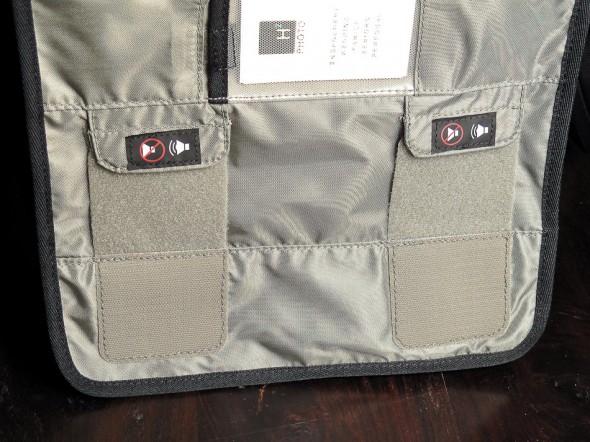
The best feature – silent velcro. In the velcro in one position the top flap secures. In the other, the velcro won’t engage. Brilliant!
Above you can see what I mean by “silent mode”. This is the main flap that flips over the top to secure the entire bag closed. On this flap, you can secure the velcro in “silent mode” so that it does not seal when the main flap is shut. This feature enables silent access to the bag, especially nice during wedding ceremonies. For a wedding photographer, this silent feature is a real dream.
I mentioned at the top this bag is not for general purpose storage and especially not for traveling. The main flap only secures with the velcro. There are no clips or zippers and little padding. Because of this, I do not recommend the bag for gear storage or travel. I use the Think Tank Airport Security to house my lighting gear and a well-padded LowePro backpack for camera gear storage or travel. If you recognize the Retrospective 20’s on-location niche, this should not be an issue. Think of it as a bag supplement.
Then again – bags are like crack to professional photographers. We can never have enough bags.
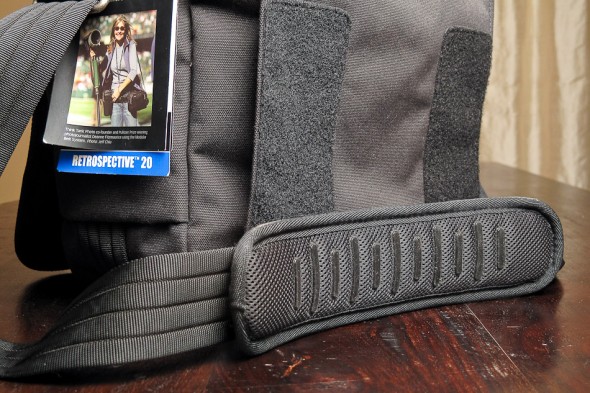
Comfortable strap – the Retrospective 20 has a well padded and adjustable strap which features anti-slip rubber pads on the bottom
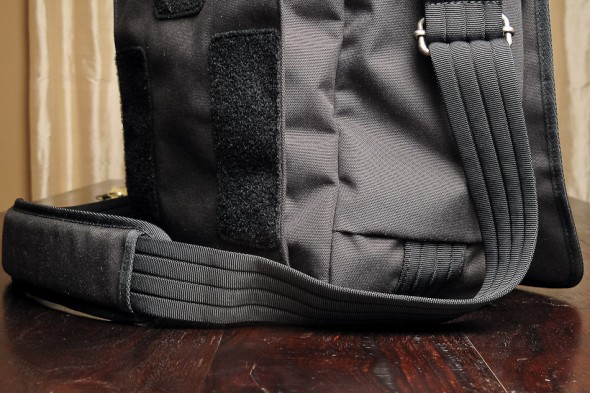
Built tough – the strap anchor points on the bag continue down the sides and under the bottom for security
The last feature worth mentioning is the strap. Again, it is very well designed with the professional photographer in mind. The shoulder pad has three main features. First, it strap pad is thick and provides all day comfort. Second, the bottom of the pad has anti-slip silicone nodules to keep the strap securely on your shoulder. Last, there is a strong friction fit between the pad and the strap. Thus, the pad will not slide out of position on the strap, but the pad can be moved to your desired position.
As for the strap security, just have a look at the last picture. The strap anchor points on the bag are nuclear-strength. Strap webbing continues down the side and across the bottom. In short – this strap will NOT come undone.
Some other nice features:
- A second top strap handle for carrying the bag in your hand
- Available in black or “pinestone” (a soft gray-green)
- Outer-side pockets to hold, um, stuff
- Big outer-back pocket large enough to hold an iPad
- Comes with a weather-sealed rain cover, which can tether to the bag
- Has a lanyard for your keys
- Strap can be easily adjusted for taller or shorter people
- Comes with a couple extra dividers, but you really don’t need them
What’s the downside
Certainly not the on-location niche. However, here is a short list of possible improvements –
- Including a clip on the main flap in addition to the “silent” velcro would give extra peace of mind.
- The bottom of the bag could use a little more padding. I certainly would not want to drop the bag by mistake, even from a short distance.
- The cost – at $159 the price is steep. Then again, professional photography bags from any company are not cheap.
Do I like it? Yeah, you can have my Retrospective 20 when you pry it from my cold dead hands.
